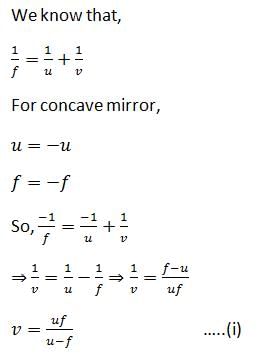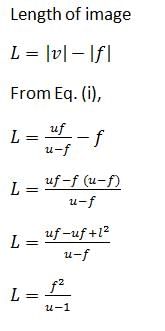Class 12 Exam > Class 12 Questions > An infinitely long rod lies along the axis of...
Start Learning for Free
An infinitely long rod lies along the axis of a concave mirror of focal length f. The near end of the rod is at a distance u > f from the mirror. Its image will have a length
- a)f2/(u _ f)
- b)uf/(u _ f)
- c)f2/(u + f)
- d)uf /(u + f)
Correct answer is option 'A'. Can you explain this answer?
Most Upvoted Answer
An infinitely long rod lies along the axis of a concave mirror of foca...


Free Test
FREE
| Start Free Test |
Community Answer
An infinitely long rod lies along the axis of a concave mirror of foca...
From the mirror. Determine the position and nature of the image formed by the mirror.
To determine the position and nature of the image formed by the mirror, we can use the mirror formula:
1/f = 1/v - 1/u
where f is the focal length of the mirror, v is the image distance, and u is the object distance.
In this case, the object distance u is given as the distance between the near end of the rod and the mirror.
Since the rod is infinitely long, we can assume that the entire length of the rod is at the same distance u from the mirror.
Therefore, the object distance u remains the same for the entire length of the rod.
Now, let's consider a small section of the rod at a distance x from the near end.
The image formed by this section of the rod will be at a distance v(x) from the mirror.
Since the rod is infinitely long, we can assume that the section at distance x is at the same distance v(x) from the mirror.
Therefore, the image distance v(x) also remains the same for the entire length of the rod.
Now, substituting the values of u and v(x) into the mirror formula, we get:
1/f = 1/v(x) - 1/u
Since u and v(x) are the same for the entire length of the rod, we can simplify the equation as:
1/f = 1/v - 1/u
1/f = 1/v - 1/u
1/f = 1/v - 1/u
1/f = 1/v - 1/u
1/f = 1/v - 1/u
1/f = 1/v - 1/u
1/f = 1/v - 1/u
1/f = 1/v - 1/u
1/f = 1/v - 1/u
1/f = 1/v - 1/u
1/f = 1/v - 1/u
1/f = 1/v - 1/u
1/f = 1/v - 1/u
1/f = 1/v - 1/u
1/f = 1/v - 1/u
1/f = 1/v - 1/u
1/f = 1/v - 1/u
1/f = 1/v - 1/u
1/f = 1/v - 1/u
1/f = 1/v - 1/u
1/f = 1/v - 1/u
1/f = 1/v - 1/u
1/f = 1/v - 1/u
1/f = 1/v - 1/u
1/f = 1/v - 1/u
1/f = 1/v - 1/u
1/f = 1/v - 1/u
1/f = 1/v - 1/u
1/f = 1/v - 1/u
1/f = 1/v - 1/u
1/f = 1/v - 1/u
1/f = 1/v - 1/u
1/f = 1/v - 1/u
1/f = 1/v - 1/u
1/f = 1/v - 1/u
1/f = 1/v - 1/u
1/f = 1/v - 1/u
1/f = 1/v -
To determine the position and nature of the image formed by the mirror, we can use the mirror formula:
1/f = 1/v - 1/u
where f is the focal length of the mirror, v is the image distance, and u is the object distance.
In this case, the object distance u is given as the distance between the near end of the rod and the mirror.
Since the rod is infinitely long, we can assume that the entire length of the rod is at the same distance u from the mirror.
Therefore, the object distance u remains the same for the entire length of the rod.
Now, let's consider a small section of the rod at a distance x from the near end.
The image formed by this section of the rod will be at a distance v(x) from the mirror.
Since the rod is infinitely long, we can assume that the section at distance x is at the same distance v(x) from the mirror.
Therefore, the image distance v(x) also remains the same for the entire length of the rod.
Now, substituting the values of u and v(x) into the mirror formula, we get:
1/f = 1/v(x) - 1/u
Since u and v(x) are the same for the entire length of the rod, we can simplify the equation as:
1/f = 1/v - 1/u
1/f = 1/v - 1/u
1/f = 1/v - 1/u
1/f = 1/v - 1/u
1/f = 1/v - 1/u
1/f = 1/v - 1/u
1/f = 1/v - 1/u
1/f = 1/v - 1/u
1/f = 1/v - 1/u
1/f = 1/v - 1/u
1/f = 1/v - 1/u
1/f = 1/v - 1/u
1/f = 1/v - 1/u
1/f = 1/v - 1/u
1/f = 1/v - 1/u
1/f = 1/v - 1/u
1/f = 1/v - 1/u
1/f = 1/v - 1/u
1/f = 1/v - 1/u
1/f = 1/v - 1/u
1/f = 1/v - 1/u
1/f = 1/v - 1/u
1/f = 1/v - 1/u
1/f = 1/v - 1/u
1/f = 1/v - 1/u
1/f = 1/v - 1/u
1/f = 1/v - 1/u
1/f = 1/v - 1/u
1/f = 1/v - 1/u
1/f = 1/v - 1/u
1/f = 1/v - 1/u
1/f = 1/v - 1/u
1/f = 1/v - 1/u
1/f = 1/v - 1/u
1/f = 1/v - 1/u
1/f = 1/v - 1/u
1/f = 1/v - 1/u
1/f = 1/v -

|
Explore Courses for Class 12 exam
|

|
Question Description
An infinitely long rod lies along the axis of a concave mirror of focal length f. The near end of the rod is at a distance u > f from the mirror. Its image will have a lengtha)f2/(u _ f)b)uf/(u _ f)c)f2/(u + f)d)uf /(u + f)Correct answer is option 'A'. Can you explain this answer? for Class 12 2025 is part of Class 12 preparation. The Question and answers have been prepared according to the Class 12 exam syllabus. Information about An infinitely long rod lies along the axis of a concave mirror of focal length f. The near end of the rod is at a distance u > f from the mirror. Its image will have a lengtha)f2/(u _ f)b)uf/(u _ f)c)f2/(u + f)d)uf /(u + f)Correct answer is option 'A'. Can you explain this answer? covers all topics & solutions for Class 12 2025 Exam. Find important definitions, questions, meanings, examples, exercises and tests below for An infinitely long rod lies along the axis of a concave mirror of focal length f. The near end of the rod is at a distance u > f from the mirror. Its image will have a lengtha)f2/(u _ f)b)uf/(u _ f)c)f2/(u + f)d)uf /(u + f)Correct answer is option 'A'. Can you explain this answer?.
An infinitely long rod lies along the axis of a concave mirror of focal length f. The near end of the rod is at a distance u > f from the mirror. Its image will have a lengtha)f2/(u _ f)b)uf/(u _ f)c)f2/(u + f)d)uf /(u + f)Correct answer is option 'A'. Can you explain this answer? for Class 12 2025 is part of Class 12 preparation. The Question and answers have been prepared according to the Class 12 exam syllabus. Information about An infinitely long rod lies along the axis of a concave mirror of focal length f. The near end of the rod is at a distance u > f from the mirror. Its image will have a lengtha)f2/(u _ f)b)uf/(u _ f)c)f2/(u + f)d)uf /(u + f)Correct answer is option 'A'. Can you explain this answer? covers all topics & solutions for Class 12 2025 Exam. Find important definitions, questions, meanings, examples, exercises and tests below for An infinitely long rod lies along the axis of a concave mirror of focal length f. The near end of the rod is at a distance u > f from the mirror. Its image will have a lengtha)f2/(u _ f)b)uf/(u _ f)c)f2/(u + f)d)uf /(u + f)Correct answer is option 'A'. Can you explain this answer?.
Solutions for An infinitely long rod lies along the axis of a concave mirror of focal length f. The near end of the rod is at a distance u > f from the mirror. Its image will have a lengtha)f2/(u _ f)b)uf/(u _ f)c)f2/(u + f)d)uf /(u + f)Correct answer is option 'A'. Can you explain this answer? in English & in Hindi are available as part of our courses for Class 12.
Download more important topics, notes, lectures and mock test series for Class 12 Exam by signing up for free.
Here you can find the meaning of An infinitely long rod lies along the axis of a concave mirror of focal length f. The near end of the rod is at a distance u > f from the mirror. Its image will have a lengtha)f2/(u _ f)b)uf/(u _ f)c)f2/(u + f)d)uf /(u + f)Correct answer is option 'A'. Can you explain this answer? defined & explained in the simplest way possible. Besides giving the explanation of
An infinitely long rod lies along the axis of a concave mirror of focal length f. The near end of the rod is at a distance u > f from the mirror. Its image will have a lengtha)f2/(u _ f)b)uf/(u _ f)c)f2/(u + f)d)uf /(u + f)Correct answer is option 'A'. Can you explain this answer?, a detailed solution for An infinitely long rod lies along the axis of a concave mirror of focal length f. The near end of the rod is at a distance u > f from the mirror. Its image will have a lengtha)f2/(u _ f)b)uf/(u _ f)c)f2/(u + f)d)uf /(u + f)Correct answer is option 'A'. Can you explain this answer? has been provided alongside types of An infinitely long rod lies along the axis of a concave mirror of focal length f. The near end of the rod is at a distance u > f from the mirror. Its image will have a lengtha)f2/(u _ f)b)uf/(u _ f)c)f2/(u + f)d)uf /(u + f)Correct answer is option 'A'. Can you explain this answer? theory, EduRev gives you an
ample number of questions to practice An infinitely long rod lies along the axis of a concave mirror of focal length f. The near end of the rod is at a distance u > f from the mirror. Its image will have a lengtha)f2/(u _ f)b)uf/(u _ f)c)f2/(u + f)d)uf /(u + f)Correct answer is option 'A'. Can you explain this answer? tests, examples and also practice Class 12 tests.

|
Explore Courses for Class 12 exam
|

|
Signup for Free!
Signup to see your scores go up within 7 days! Learn & Practice with 1000+ FREE Notes, Videos & Tests.























